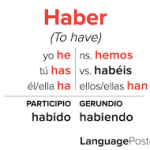Are you struggling to use the verb ‘hacer’ in Spanish? Look no further! This article will guide you through the basics of conjugating ‘hacer,’ expressing actions and activities, discussing the weather, describing age and time, and using ‘hacer’ in common expressions.
Avoid common mistakes and gain confidence in your Spanish skills.
Get ready to master the versatile verb ‘hacer’ and take your Spanish to the next level.
Let’s dive in and start making progress!
Basic Conjugation of ‘Hacer
To conjugate the verb ‘hacer’ in Spanish, you’ll use the article determiner ‘el’ and the second person pronoun ‘tú’ to form the contraction ‘haces’. This contraction is used when referring to the action of making or doing something.
For example, if you want to say ‘you make’ or ‘you do’ in Spanish, you’d say ‘tú haces’.
It’s important to note that the verb ‘hacer’ is irregular and doesn’t follow the regular conjugation patterns of other verbs. However, once you learn the conjugation of ‘hacer’, you’ll be able to use it in various contexts and situations.
Practice using ‘haces’ in different sentences to become more comfortable with this verb form.
Expressing Actions and Activities
Now that you understand how to conjugate the verb ‘hacer’ in Spanish, let’s delve into expressing various actions and activities using this versatile verb.
By following the verb conjugation rules, you can easily express what you do or what someone else does.
Additionally, there are common expressions with ‘hacer’ that are frequently used to describe different activities.
Verb Conjugation Rules
Start by using the preposition ‘en’ to express the time in which you engage in actions and activities in Spanish. This is an important aspect of verb conjugation rules. For example, if you want to say ‘I eat breakfast in the morning,’ you’d say ‘Yo desayuno en la mañana.’
Here are some more conjugation rules to keep in mind:
- Use the appropriate subject pronoun before the verb.
- Conjugate the verb according to its tense (present, past, future, etc.) and the subject pronoun.
- Pay attention to the verb endings, which change depending on the subject and tense.
- Don’t forget to use the correct verb form for each pronoun (yo, tú, él/ella/usted, nosotros/nosotras, vosotros/vosotras, ellos/ellas/ustedes).
Common Hacer Expressions
Let’s explore some common hacer expressions to express actions and activities in Spanish.
One common expression is ‘hacer ejercicio,’ which means ‘to exercise.’ This can refer to any type of physical activity, such as running, swimming, or going to the gym.
Another expression is ‘hacer la cama,’ which means ‘to make the bed.’ This is a simple everyday task that many people do in the morning.
‘Hacer la compra’ means ‘to do the shopping’ and is used when talking about buying groceries or other items.
Additionally, ‘hacer una fiesta’ means ‘to throw a party’ and is used when organizing a celebration.
These are just a few examples of how the verb ‘hacer’ can be used to express different actions and activities in Spanish.
Talking About the Weather
To talk about the weather in Spanish, you can use the phrase ‘Hace’ followed by the appropriate weather condition. For example, you can say ‘Hace sol’ (It’s sunny), ‘Hace calor’ (It’s hot), ‘Hace frío’ (It’s cold), or ‘Hace viento’ (It’s windy).
Here are some more weather conditions you can use with ‘Hace’:
- Hace buen tiempo (It’s good weather)
- Hace mal tiempo (It’s bad weather)
- Hace fresco (It’s cool)
- Hace bochorno (It’s muggy)
Using ‘Hace’ is a simple and effective way to talk about the weather in Spanish. Remember to use the appropriate adjective after ‘Hace’ to describe the current weather condition.
Describing Age and Time
Para describir tu edad en español, se utiliza el verbo ‘hacer’. Por ejemplo, si tienes veinte años, dirías ‘Tengo veinte años’ o ‘Hago veinte años’.
El verbo ‘hacer’ se usa para indicar la cantidad de tiempo que ha pasado desde que naciste.
Además de describir la edad, también puedes usar ‘hacer’ para hablar del tiempo transcurrido. Por ejemplo, si quieres decir ‘Hace dos horas que llegué’, dirías ‘Llegué hace dos horas’.
En resumen, el verbo ‘hacer’ es útil para describir tanto la edad como el tiempo transcurrido en español.
Using ‘Hacer’ in Expressions
To incorporate ‘hacer’ into expressions, you can use it to convey the passage of time or the duration of an action. It’s a versatile verb that can be used in various contexts. Here are some ways in which you can use ‘hacer’ in expressions:
- Hace mucho tiempo: It has been a long time.
- Hace dos horas: It has been two hours.
- Hace frío: It’s cold.
- Hace calor: It’s hot.
Using ‘hacer’ in these expressions allows you to describe the duration of an action or convey the current weather conditions. By incorporating ‘hacer’ into your Spanish vocabulary, you’ll be able to express yourself more accurately and effectively.
Discussing Past Actions
Now let’s talk about discussing past actions using ‘hacer’ in Spanish.
‘Hacer’ is commonly used to express completed actions in the past. For example, you can say ‘Hace dos días, fui al cine’ which means ‘Two days ago, I went to the cinema.’
Additionally, ‘hacer’ is used in time expressions like ‘hace una semana’ (a week ago), ‘hace un año’ (a year ago), and so on.
It’s important to understand the usage of ‘hacer’ and how it differs from other verbs when discussing past actions in Spanish.
Hacer’ for Completed Actions
First, let’s talk about how you can use ‘hacer’ to talk about completed actions in the past.
- ‘Hacer’ can be used to express the duration of time that has passed since an action occurred. For example, ‘Hace dos días fui al cine’ means ‘I went to the movies two days ago.’
- It can also be used to indicate the time when an action took place. For instance, ‘Hizo frío ayer’ means ‘It was cold yesterday.’
- ‘Hacer’ can be used in questions to ask how long ago something happened. For example, ‘¿Cuánto tiempo hace que llegaste?’ means ‘How long ago did you arrive?’
- Additionally, ‘hacer’ can be used to talk about past habits or actions that were done repeatedly. For instance, ‘Hacía ejercicio todos los días’ means ‘I used to exercise every day.’
Using ‘hacer’ in these ways will allow you to discuss past actions with ease and accuracy.
Time Expressions With ‘Hacer
When using ‘hacer’ to discuss past actions, you can incorporate time expressions to provide specific details about when an action occurred. This allows you to communicate more precisely and give a clearer picture of the timeline.
For example, you can say ‘Hace dos días hice la tarea’ (Two days ago, I did the homework) or ‘Hace una semana fui al cine’ (A week ago, I went to the movies). By using the expression ‘hace’ followed by a time period, you can indicate how long ago the action took place.
Additionally, you can use expressions like ‘hace mucho tiempo’ (a long time ago) or ‘hace poco’ (recently) to further specify the time frame. Incorporating time expressions with ‘hacer’ in Spanish allows you to provide more context and enhance your communication skills.
Hacer’ Vs Other Verbs
To compare ‘hacer’ with other verbs when discussing past actions, consider its usage and nuances in relation to different concrete nouns. When talking about past actions, ‘hacer’ is often used to express the idea of doing or making something. However, it’s important to note that ‘hacer’ isn’t always the best choice and other verbs may be more appropriate depending on the specific action being described. Here are some examples to illustrate the differences:
- ‘Hacer la cama’ (to make the bed) vs ‘Arreglar la cama’ (to tidy up the bed)
- ‘Hacer la cena’ (to make dinner) vs ‘Cocinar la cena’ (to cook dinner)
- ‘Hacer ejercicio’ (to do exercise) vs ‘Practicar deporte’ (to practice sports)
- ‘Hacer los deberes’ (to do homework) vs ‘Estudiar’ (to study)
While ‘hacer’ is a versatile verb, it’s important to consider the specific action and choose the appropriate verb to convey the intended meaning accurately.
Phrases With ‘Hacer
You can use ‘hacer’ in Spanish to express different actions or activities. There are several phrases with ‘hacer’ that you should know.
For example, you can use ‘hacer deporte’ to mean ‘to do sports’ or ‘to exercise.’
If you want to say ‘to do homework,’ you’d say ‘hacer la tarea.’
To express ‘to do the dishes,’ you’d use ‘hacer los platos.’
Another common phrase is ‘hacer una pregunta,’ which means ‘to ask a question.’
If you want to say ‘to make a decision,’ you’d say ‘hacer una decisión.’
Additionally, you can use ‘hacer una fiesta’ to mean ‘to throw a party.’
These are just a few examples of the many phrases that use ‘hacer’ in Spanish.
Common Mistakes to Avoid
To avoid common mistakes when using ‘hacer’ in Spanish, make sure to use the appropriate quantifier determiner. Here are some common mistakes to avoid:
- Using ‘hacer’ with a specific time instead of using a specific verb:
Instead of saying ‘Hago una siesta a las 3 de la tarde,’ you should say ‘Duermo una siesta a las 3 de la tarde.’ - Using ‘hacer’ to express age:
Instead of saying ‘Hace 30 años que tengo,’ you should say ‘Tengo 30 años.’ - Using ‘hacer’ to express the completion of an action:
Instead of saying ‘Hace dos horas que termino mi tarea,’ you should say ‘Terminé mi tarea hace dos horas.’ - Using ‘hacer’ to express the weather:
Instead of saying ‘Hace sol,’ you should say ‘Está soleado.’
Frequently Asked Questions
Can ‘Hacer’ Be Used to Express Future Actions?
Yes, ‘hacer’ can be used to express future actions in Spanish. It is commonly used to talk about future plans or to ask about someone’s future activities.
How Do You Conjugate ‘Hacer’ in the Present Subjunctive?
To conjugate ‘hacer’ in the present subjunctive, you take the yo form of the verb (‘hago’) and replace the -o with the corresponding subjunctive endings. So, for ‘hacer’, it becomes ‘hagas’.
Are There Any Idiomatic Expressions With ‘Hacer’?
There are indeed many idiomatic expressions with ‘hacer’ in Spanish. It’s important to learn them as they are commonly used in everyday conversations. Let’s explore some of them together!
Can ‘Hacer’ Be Used to Express Emotions or Feelings?
Yes, ‘hacer’ can be used to express emotions or feelings. For example, you can say “hace frío” to express that it’s cold, or “hace calor” to say it’s hot.
What Are Some Common Mistakes People Make When Using ‘Hacer’ in Spanish?
Common mistakes people make when using ‘hacer’ in Spanish include using it too broadly to mean ‘to make’ or ‘to do’ without considering the specific context or using it incorrectly in idiomatic expressions.
Conclusion
In conclusion, the verb ‘hacer’ is a versatile and essential word in the Spanish language. It’s used to express actions, describe the weather, talk about age and time, and form various expressions.
By understanding the basic conjugation of ‘hacer’ and its different uses, learners can effectively communicate in Spanish. However, it’s important to avoid common mistakes when using this verb.
With practice and attention to detail, one can confidently incorporate ‘hacer’ into their Spanish conversations.


